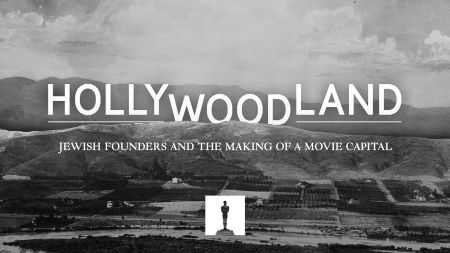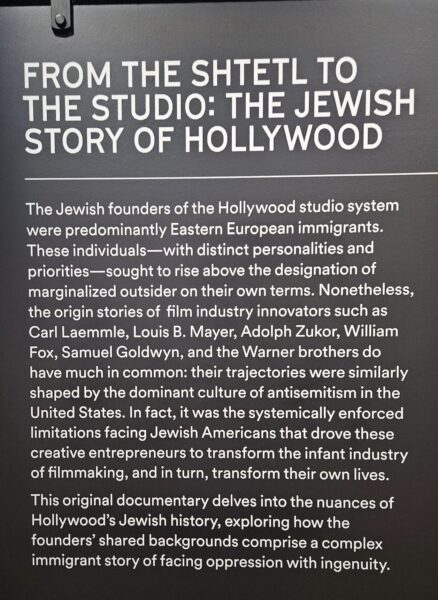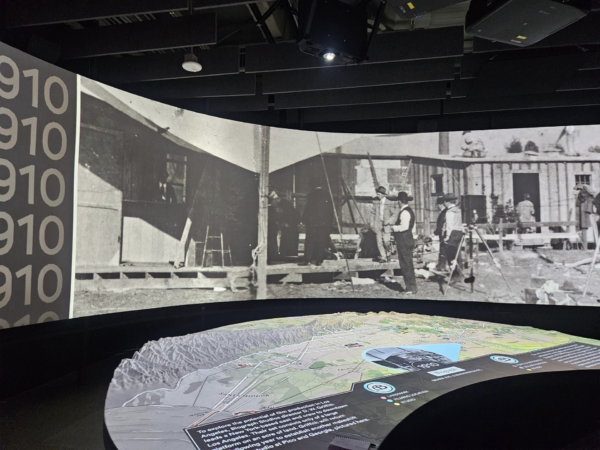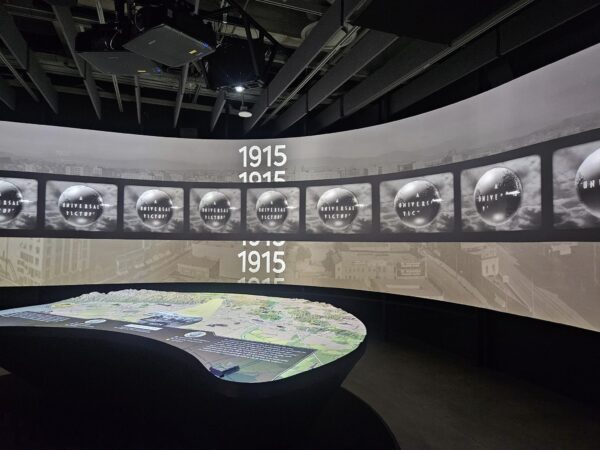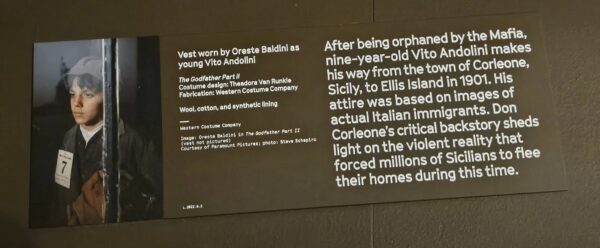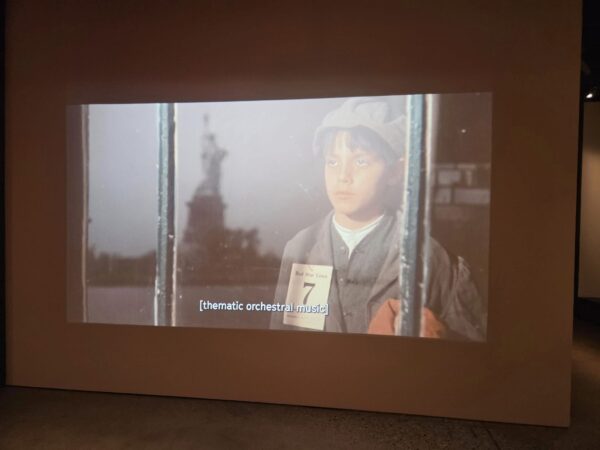GIVING JEWISH IMMIGRANTS AND FILM FOUNDERS
THEIR DUE — PERMANENTLY
As its first permanent exhibition, The Academy Museum of Motion Pictures is presenting Hollywoodland: Jewish Founders and the Making of a Movie Capital which tells the origin story of filmmaking in early 20th-century Los Angeles, spotlighting the impact of the predominantly Jewish filmmakers whose establishment of the American film studio system transformed Los Angeles into a global epicenter of cinema, Presented in both English and Spanish, the long-overdue historical exhibit — which opened May 19, 2024 — honors those who rose up from poverty in Eastern Europe, came to a new land, and through their personal determination to make a better life for themselves as Americans, created an industry and studio system which still thrives today.
And since all four of my grandparents as well as my father came to America the same way, this exhibit offered me a chance to witness via film and photo archives the types of hardships they endured to establish our family’s foothold on our own American Dream in Los Angeles. Here are a few details from the exhibit that really hit home for me, and will for everyone who traces their ancestry back to countries across oceans.
Chronological, multimedia, 3-D display of the burgeoning Hollywood Studios and landmarks.
From 1881-1914, two million Eastern European Jews left their homeland due to pogroms threatening their lives and families. After struggling to book ocean passage, each came to the United States (sometimes orphaned children arrived alone) and were processed though Ellis Island in the hope of making a new and better life for themselves, first in New York. Confined to neighborhoods designated for them, these Jewish immigrants then faced limits on what types of work they were allowed to do, usually as factory workers for Protestant “elitist” business owners, who offered them no chance of advancement into management even though many were highly educated and from professional occupations.
Studio history
But soon those living on the crowded tenement streets of New York were spending their time in small storefront Nickelodeon theaters, watching new, very short film entertainment – motion pictures! Some of those laughing their troubles away inside those early movie houses were Jewish immigrants who desired to assimilate into American culture. And being part of the society to which this type of entertainment was aimed, they knew the type of films that would be the most successful for the masses. But how to do that?
Galleries
As they witnessed the explosion of film popularity, a few very intelligent Jewish immigrant factory workers realized the new unregulated motion picture business was wide open for entrepreneurs to advance their place in the business world and give them a chance to gain acceptance into the higher echelon of American society they so desired. Thus began their first steps into the movie business by owning neighborhood Nickelodeons, learning what movies worked best for the masses who bought tickets, then marketing movies made by others, then producing their own for distribution. The natural next step was building their own facilities where even bigger movies could be made. But where?
D.W. Griffith of UA
Since Eastern European Jewish immigrants were prohibited from owning businesses in New York, a few early movie pioneers realized there were many more possibilities for advancement both professionally and socially in Los Angeles, where land was cheap and the weather would allow them to work year-round. Some of these determined Eastern European immigrants (and their children) moved here and established the eight movie studios which gave birth to the Hollywood film industry as we know it. Each of them and their studio’s history are featured in entertaining and educational detail.
United Artists Theatre, Los Angeles, California, 1929, during the run of Coquette, 1929. After becoming a church, then Theatre at the Ace Hotel, the gorgeous movie palace still has concerts and shows film. It is now The United Theatre on Broadway. Courtesy Margaret Herrick Library, Academy of Motion Picture Arts and Sciences
Located in the museum’s LAIKA Gallery, Hollywoodland is an immersive exhibition chronicling the studio system’s evolution during the early 20th century. It details how the American movie industry — built predominately by Jewish immigrants — transformed Los Angeles into the mythological concept of “Hollywood” that prevails today, as well as the complex legacy that the studio system leaves behind. The exhibition is elaborated in three distinct parts: Studio Origins, an exploration of the founding of Hollywood’s original eight “major” film studios (often referred to as “the majors”) and their respective studio heads; Los Angeles: From Film Frontier to Industry Town, 1902–1929, an immersive projection experience where visitors trace the evolving landscape of Los Angeles alongside the advancement of the movie industry; and From the Shtetl to the Studio: The Jewish Story of Hollywood, a short form documentary, narrated by TCM host and author Ben Mankiewicz, that illustrates the experiences of the Jewish immigrants and first-generation Jewish Americans who were primarily responsible for building the Hollywood studio system. The exhibition is designed for visitors to enter and exit through the same door so that they can experience these three sections in any order.
Mabel Normand 1916 behind the camera. Courtesy Margaret Herrick Library (Academy of Motion Picture Arts and Sciences)
Please set aside several hours to fully experience the wonderful historical knowledge presented in all three parts of the exhibit between the hours of 10am-6pm daily except Tuesday when the entire facility is closed. Take your time, indulger your mind and senses, linger over details being told, and appreciate what these early Angelenos did for our city and cultural landscape. Here are details about the three-part of the exhibit.
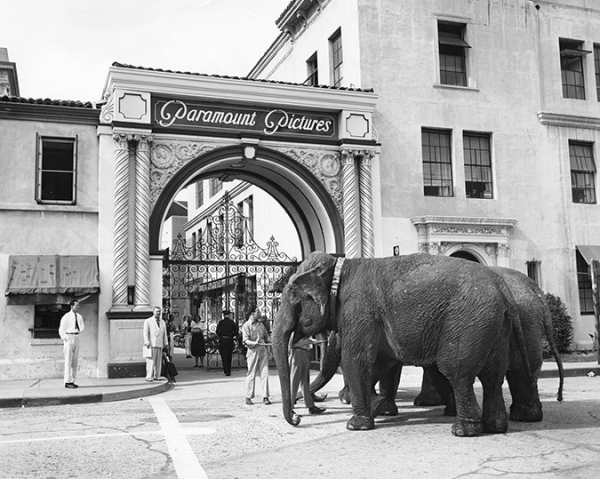 Elephants in front of the studio gates at Paramount
Paramount Pictures/Margaret Herrick Library (Academy of Motion Picture Arts and Sciences)
Elephants in front of the studio gates at Paramount
Paramount Pictures/Margaret Herrick Library (Academy of Motion Picture Arts and Sciences)Studio Origins explores the establishment of the studio system and “the majors” — Universal, Fox (later Twentieth Century-Fox), Paramount, United Artists, Warner Bros., Columbia, Metro-Goldwyn-Mayer, and RKO — and the studio heads that shaped them. Visitors will learn about each studio’s origin story through dedicated multimedia displays highlighting significant milestones, movies, filmmakers, locations, and gain a deeper understanding of how the studio system transformed the American film industry.
Display on The Jazz Singer
Each studio exhibit features movie posters, historical photos, and artifacts from their beginnings through the present. Founders of Eastern European Jewish ancestry noted are:
- Paramount –Adolph Zukor and Jesse L Lasky
- Columbia –Harry Cohn, the only founding studio executive who ran his studio for his entire life
- RKO –David Sarnoff in New York who made the studio world famous for its lavish musicals using sound equipment created by RCA, and David O. Selznick who was one of several who managed the studio in Los Angeles.
- United Artists –Los Angeles-based film stars Charlie Chaplin, Douglas Fairbanks, Mary Pickford, and director D.W. Griffith as a fair working environment for creatives. The studio was managed by Jewish immigrants Hiram Abrams and Joseph Schenck, who went on to co-found 20th Century Fox.
- MGM – Samuel Goldwyn and Louis B. Mayer. Their original lot in Culver City now houses Sony, where movies and television shows are done.
- Warner Bros. – Founded by brothers Harry M. Warner and Jack L. Warner, and their sons.
- Universal – Founded by Carl Laemmle who took Thomas Edison to court to break up his monopoly owning all the equipment needed to make movies and charging a fee to anyone wanting to use the equipment. Thus, he was one to open up making movies to everyone.
- Fox – Founded by William Fox who bought Tom Mix’s former ranch in West Los Angeles and built his studio there, which today houses 20th Century Fox. After the financial debacle called Cleopatra in the 1960s, Fox sold 180 acres of the lot, which became Century City in 1967, and its famous backlots in Culver City which are now privately-owned residential condominium properties named for films created there: Raintree, Tara Hill, and Lakeside.
Please take your time to watch the complete Los Angeles: From Film Frontier to Industry Town, 1902–1929 which illustrates how the landscape of Los Angeles developed alongside the newly established and quickly expanding film industry, redefining the city itself. Consisting of an animated tabletop map of Los Angeles and choreographed projection screen, this section of the exhibition features a timeline structured around a series of chronologically revealed locations relevant to the city’s early film industry, such as filming locations, studio locations, and cultural landmarks. It also addresses lesser-known stories of independent producers arriving in early 1900s Los Angeles. While 1902–1929 is the focused timeline, the experience quickly “rewinds” and “fast-forwards” in and out of the present day to connect and ground visitors in a current, more familiar version of Los Angeles. The map encourages visitors to further explore this history through the Academy Museum’s digital Hollywood Past and Present experience.
Warner Bros. display
An exploration of the Eastern European Jewish immigration experience is display during the original short-film documentary From the Shtetl to the Studio: The Jewish Story of Hollywood that delves into the nuances of Hollywood’s Jewish history, exploring how the shared backgrounds of the industry founders represent a complex immigrant story characterized by both oppression and innovation. Narrated by Ben Mankiewicz, the documentary features archival imagery and film clips, illustrating the larger global context at the turn of the 20th century as well as personal narratives of the predominantly Jewish founders of the Hollywood studio system. The film examines how antisemitism shaped the founders’ trajectories throughout their careers and how their projected vision of an immigrant’s American Dream came to define America itself on movie screens around the world. Take a seat and watch the birth of the Hollywood Studio system unfold before your eyes!
Sam Warner, Harry M. Warner, Jack L. Warner, and Albert Warner, undated, courtesy Margaret Herrick Library, Academy of Motion Picture Arts and Sciences.
A fascinating element about the exhibit is how the early motion pictures created by Eastern European Jewish immigrants, such as It’s a Wonderful Life and Mr. Smith Goes to Washington, reflect the idealized American life they imagined to be true and wanted for themselves, yet none featured Jewish characters. Their early tough-guy movies about gangsters from inner cities fighting for territory, which others like themselves from that environment, enjoyed for the action sequences and great escapes.
The Hollywood Sign, ca. 1924, courtesy of Margaret Herrick Library
Thus, the studio system put in place by its founders set the pattern for transformation against impossible odds – something they had done for themselves and wanted to express through their artistic endeavors to inspire others to do the same. But, of course, the idealized lives expressed in their movies was often far from how Americans really lived, but appealed to those wanting a better life for themselves. Their imaginary early depictions of American life continue to dictate the writing of movies to this day, especially in the ever-popular rom-coms which always have a happy ending or the action-adventure movies which keep millions of modern thrill-seekers going to movie theaters daily.
Louis B. Mayer, ca. 1924, courtesy of Margaret Herrick Library
Be sure to save time to walk through other galleries relating to immigration as expressed in Hollywood movies, such as The Godfather which displays a photo of young Vito Corleone as a newly arrived and processed Italian orphan looking out with hope and fear from an Ellis Island window at the Statue of Liberty. Or look at the immigrants anxiously awaiting their “papers” to get out of Casablanca while at Rick’s listening to Sam play American blues and Jazz, with his original on-screen piano on display.
With the rise in antisemitism around the world, and this being Pride Month, now is the perfect time to take your children to this exhibit to open their eyes on how unfair and destructive it is to perpetuate hate for perceived differences rather than honoring our humanity and how we need to work together towards a better world, just as the Eastern European Jewish founders of the Hollywood movie studio system wanted acceptance based on their talent and not to be dismissed simply due to their religion.
The Godfather Office
Sam's Piano from Casablanca
Hollywoodland is curated by Dara Jaffe, associate curator, with support from Gary Dauphin, former associate curator of digital presentations, and Josue L. Lopez, research assistant. Author and film critic Neal Gabler is an advisor for the exhibition.
photos by the author, unless noted
Hollywoodland: Jewish Founders and the Making of a Movie Capital
The Academy Museum, 6067 Wilshire Blvd. (corner of Fairfax) in Los Angeles
open daily except Tuesday 10am-6pm for general admission tickets;
tickets for evening admission for special screenings and events sold separately
info on exhibits, special screenings/events, parking, local restaurants,
and to purchase tickets, visit Academy Museum
